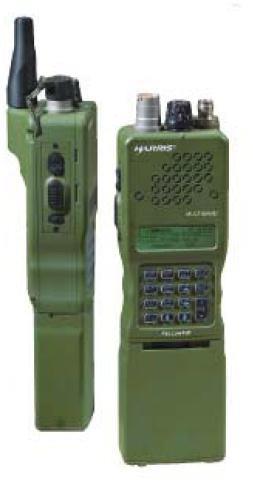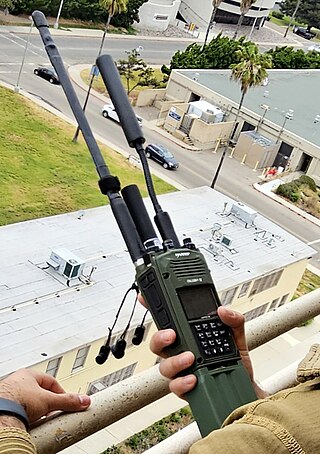
MIL-STD-188 is a series of U.S. military standards relating to telecommunications.

High frequency (HF) is the ITU designation for the range of radio frequency electromagnetic waves between 3 and 30 megahertz (MHz). It is also known as the decameter band or decameter wave as its wavelengths range from one to ten decameters. Frequencies immediately below HF are denoted medium frequency (MF), while the next band of higher frequencies is known as the very high frequency (VHF) band. The HF band is a major part of the shortwave band of frequencies, so communication at these frequencies is often called shortwave radio. Because radio waves in this band can be reflected back to Earth by the ionosphere layer in the atmosphere – a method known as "skip" or "skywave" propagation – these frequencies are suitable for long-distance communication across intercontinental distances and for mountainous terrains which prevent line-of-sight communications. The band is used by international shortwave broadcasting stations (3.95–25.82 MHz), aviation communication, government time stations, weather stations, amateur radio and citizens band services, among other uses.
Mixed-excitation linear prediction (MELP) is a United States Department of Defense speech coding standard used mainly in military applications and satellite communications, secure voice, and secure radio devices. Its standardization and later development was led and supported by the NSA and NATO. The current "enhanced" version is known as MELPe.

The Joint Tactical Radio System (JTRS) aimed to replace existing radios in the American military with a single set of software-defined radios that could have new frequencies and modes (“waveforms”) added via upload, instead of requiring multiple radio types in ground vehicles, and using circuit board swaps in order to upgrade. JTRS has seen cost overruns and full program restructurings, along with cancellation of some parts of the program.
Link 16 is a military tactical data link network used by NATO members and other nations, as allowed by the MIDS International Program Office (IPO). Its specification is part of the family of Tactical Data Links.

Secure voice is a term in cryptography for the encryption of voice communication over a range of communication types such as radio, telephone or IP.
TADIL-A/Link 11 is a secure half-duplex tactical data link used by NATO to exchange digital data. It was originally developed by a joint committee including members from the Royal Canadian Navy, US Navy and Royal Navy to pass accurate targeting information between ships. The final standard was signed in Ottawa in November 1957, where the British proposed the name "TIDE" for "Tactical International Data Exchange". It was later made part of the NATO STANAG standardization process.
Multiple frequency-shift keying (MFSK) is a variation of frequency-shift keying (FSK) that uses more than two frequencies. MFSK is a form of M-ary orthogonal modulation, where each symbol consists of one element from an alphabet of orthogonal waveforms. M, the size of the alphabet, is usually a power of two so that each symbol represents log2M bits.
Bowman is the name of the tactical communications system used by the British Armed Forces.

Clansman is the name of a combat net radio system (CNR) used by the British Army from 1976 to 2010.

Larkspur was the retrospectively adopted name of a tactical radio system used by the British Army. Its development started in the late 1940s with the first equipment being issued in the mid-1950s. It remained in service until replaced by Clansman in the late-1970s although some elements of Larkspur were still in service well into the 1980s. It was widely exported to British Commonwealth armies and other friendly nations.

The AN/PRC-152 Multiband Handheld Radio, is a portable, compact, tactical software-defined combat-net radio manufactured by Harris Corporation. It is compliant without waivers to the Joint Tactical Radio System (JTRS) Software Communications Architecture (SCA). It has received NSA certification for the transmission of Top Secret data.

The AN/PRC-117 translates to "Army/Navy, Portable, Radio, Communication". It is a man-portable, tactical software-defined combat-net radio, manufactured by Harris Corporation, in two different versions:
Barrett Communications is a specialist manufacturer and supplier of commercial high frequency (HF), tactical HF and very high frequency (VHF) communications equipment. Its head office for design and manufacturing is located in Perth, Western Australia. Barrett was acquired by Motorola Solutions in 2022.
The Yaesu FT-ONE is an all-mode solid state general coverage HF amateur radio (HAM) transceiver. The use of FM required an optional FM board to be installed. The unit was designed for fixed, portable or mobile operation, although the size and weight (17 kg) made it more suitable for fixed use. The FT-ONE was built by the Japanese Yaesu-Musen Corporation from 1982 to 1986. At its release, the FT-ONE was launched as the successor to the FT-902 and as the new Yaesu top-of-the-line transceiver. The FT-ONE was not only Yaesu's first fully synthesized, computer-controlled amateur band transceiver but it was also the first transceiver with a general coverage receiver. The FT-ONE was sold in the U.S., Asian and European markets. It was released in 1982 with a list price of $2800.00 US.
The AN/PRC-10 is an American VHF portable radio transceiver, introduced in 1951 as a replacement for the wartime SCR-300 set. The AN/PRC-8 and AN/PRC-9 sets are basically the same but cover lower frequency bands. It remained in service with the American military until the mid 1960s when it was replaced by the transistorized AN/PRC-25 set.

HRM-7000 is a German military shortwave-transceiver of Elbit Systems, formerly Telefunken Racom. It is one of the Communication systems of the German Bundeswehr.

The AN/PRC-163 Multi-channel Handheld Radio, is a dual-channel tactical handheld radio manufactured by L3Harris Technologies, Inc. for the U.S. military, referred to by the U.S. Army as the Leader Radio. It is capable modes such as VHF/UHF Line-of-Sight (VULOS), SINCGARS, Soldier Radio Waveform, Tactical Scalable MANET, P25 as well as the Mobile User Objective System satellite communication mode. The dual channel capability allows a soldier to simultaneously communicate on two separate radio networks. It has received NSA certification for the transmission of Top Secret information with an appropriate encryption key. The PRC-163 is one of the Handheld, Manpack & Small Form Fit (HMS) components of the Integrated Tactical Network family of radios, the U.S. Army's modernization strategy for tactical radios. It is a member of L3Harris' Falcon IV family of tactical radios, and the successor to the Falcon III-family AN/PRC-152 Multiband Handheld Radio.

The AN/PRC-160 Wideband HF/VHF Manpack Radio, is a tactical HF/VHF manpack radio manufactured by L3Harris. The PRC-150 is the manpack HF radio for the Harris Falcon III family of radios. It replaces the earlier AN/PRC-150, with a smaller form factor and lighter weight than its predecessor, and being capable of 4th Generation Automatic Link Establishment, achieving data transmission speeds up to 10 times faster.











